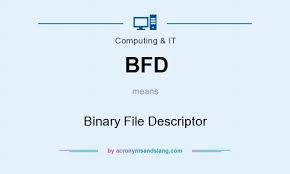In computing, handling data efficiently is key to building reliable software and systems. One concept that helps programmers manage this is the Binary File Descriptor (BFD). It is a crucial tool for those working with binary files in systems programming, linking, and debugging. In this blog post, we will explore what BFD is, how it functions, and its role in the development process.
What is a Binary File Descriptor (BFD)?
The Binary File Descriptor (BFD) is a system library that provides a common interface for reading and writing binary files, such as object files, executables, or shared libraries. BFD is widely used in GNU development tools, including the GNU Debugger (GDB) and GNU Binutils (binary utilities like objdump and ld).
Essentially, BFD abstracts the differences between various binary file formats, allowing programmers to write tools that can interact with different formats without needing to write custom code for each format. This abstraction supports cross-platform development, enabling programs to be built and executed across multiple systems.
Key Functions of BFD
The BFD library offers several essential features, making it a versatile tool in the development process. Here are some of the key functionalities:
- Binary File Compatibility: BFD supports multiple binary formats, such as ELF (Executable and Linkable Format), COFF (Common Object File Format), a.out, and PE (Portable Executable), among others. It allows tools like
ld(the GNU linker) andobjdumpto read and manipulate files in different formats without worrying about underlying differences. - Symbol Table Handling: BFD provides an interface to work with symbol tables, which hold information about variables, functions, and other entities in a program. This is particularly useful in linking, debugging, and code analysis.
- Relocation Processing: In systems programming, relocation refers to adjusting addresses in binary code when it is loaded into memory. BFD simplifies this process by providing relocation support across different binary formats.
- Dynamic and Static Linking: The library is integral to both static and dynamic linking processes, helping resolve symbols and manage object files during the linking phase of program compilation.
- Debugging Support: BFD aids debugging tools by providing access to symbol tables, debug information, and sections of binary files. This makes it easier to interpret and analyze programs during execution.
- Cross-Platform Development: By providing a unified interface for various binary formats, BFD allows developers to create tools that work across different systems, making it an essential library for cross-compilation and porting projects.
How BFD Works
The BFD library provides functions that allow programs to:
- Open and close binary files in various formats.
- Read and write data to/from these files.
- Manipulate sections, symbols, and relocation entries.
When working with BFD, programmers often follow these steps:
- File Identification: BFD first identifies the file format (e.g., ELF, COFF) using its built-in mechanisms.
- Accessing Data: Once the format is identified, the library allows access to different sections of the file, such as the symbol table or relocation entries.
- Manipulating Data: After accessing the file’s contents, developers can use BFD to manipulate them, whether they need to update symbols, process relocation, or extract debugging information.
- Closing the File: After the required operations are complete, BFD ensures the proper closure and cleanup of the binary file, maintaining system stability.
Applications of BFD
The Binary File Descriptor library is an indispensable part of the development process in various contexts:
- Compilers: BFD is integral to the functionality of GNU compilers like GCC, where it helps handle different object file formats and enables cross-platform compilation.
- Linkers: The GNU linker (ld) uses BFD to combine object files into an executable or library, resolving symbols and performing necessary relocations.
- Debuggers: GDB, the GNU Debugger, relies on BFD to read executable files and access symbol information. This enables debugging tools to analyze program behavior effectively.
- Binary Analysis: Tools like objdump and nm, which display information about object files, use BFD to interpret and present binary data.
Challenges and Considerations
While BFD provides a powerful abstraction for handling binary files, it also introduces some complexity:
- Performance Overhead: The abstraction layer of BFD can sometimes introduce performance overhead when dealing with large files or highly optimized code, as the library tries to interpret various file formats.
- Complexity in Debugging: Since BFD is designed to work with multiple file formats, developers using BFD need to have a good understanding of the different formats they are working with.
- Learning Curve: The BFD library has a steep learning curve for developers new to systems programming or those unfamiliar with the binary formats it supports.
Conclusion
The Binary File Descriptor (BFD) is an essential tool in the GNU development ecosystem, offering a unified interface for handling binary files in various formats. Its ability to support symbol tables, relocation processing, and cross-platform development makes it invaluable in the fields of compilers, linkers, and debugging tools.
By abstracting the details of different binary formats, BFD allows developers to focus on the functionality of their tools rather than worrying about the specifics of file formats. Although it introduces some complexity, the benefits far outweigh the challenges, especially in environments where multiple binary formats are common.
Looking for custom development tools or systems programming support? At TechsterTech.com, we provide expert-level web development, IT consulting, and system engineering services to help your business thrive. Explore our services at TechsterTech.com or contact us at admin@techstertech.com to learn more.



